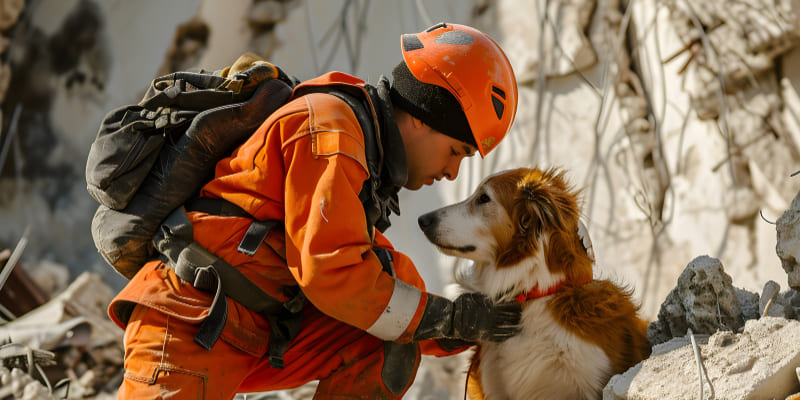Can Pets Sense Natural Disasters Before They Happen?
—
Eyewitness Stories vs. Scientific Proof
For decades, thousands of pet owners have shared similar stories: dogs pacing or whining minutes before an earthquake, cats suddenly frantic before a storm, birds restless ahead of a wildfire. These anecdotes are emotionally powerful and sometimes correlate closely with real events. However, compelling anecdotes do not equal conclusive scientific proof. Researchers have studied animal behavior around natural disasters with mixed results — intriguing signals exist, but they’re inconsistent and difficult to control in a lab setting.
How Pets Might Detect Danger
Scientists have proposed several non-mystical mechanisms that could explain why animals sometimes appear to "know" before disasters strike:
- Superior hearing and vibration sensitivity: Many animals hear higher or lower frequencies than humans and can detect subtle ground vibrations or low-frequency sounds (infrasound) generated by tectonic activity or distant storms.
- Olfactory cues: Animals have far keener noses than humans. Changes in air chemistry, scents carried on winds, or odors released by stressed earth or vegetation might be detectable long before we notice anything unusual.
- Electromagnetic or infrasound sensitivity (theory): Some hypotheses suggest animals may sense shifts in electromagnetic fields or very low-frequency sounds produced by earth stress or storms. Evidence here remains controversial and not firmly established.
- Environmental and ecosystem changes: Subtle shifts in insect activity, water chemistry, or animal prey behavior can cascade through an ecosystem, alerting local animals before humans observe the change.
- Human cueing and conditioning: Pets are highly attuned to human routines and emotions. If owners act differently before a storm (packing, checking forecasts), pets will pick up on those cues. Over time, pets may learn to associate certain cues with upcoming events.
What the Research Shows
The scientific record is mixed. Some controlled and observational studies report statistically significant changes in animal behavior prior to earthquakes or extreme weather, while others find no clear pattern or results that are not easily replicated. Challenges include small sample sizes, the difficulty of controlling variables in open environments, and the strong tendency to remember dramatic cases while forgetting non-events (a form of recall bias).
Bottom line: research suggests animals can detect certain precursors in some circumstances, but not reliably enough to be used as a sole early-warning system.
Which Animals Seem Most Sensitive?
- Dogs: Frequently reported as responsive to storms and earthquakes — barking, pacing, whining, or hiding.
- Cats: Often become clingy, hide, or show restless behavior; their responses can be subtler and easier to miss.
- Birds and small mammals: Changes in vocalization, agitation, or flight behavior have been noted before storms or fires.
- Livestock & wildlife: Herd movements or unusual migrations have been observed prior to floods, earthquakes, and other events.
Individual temperament, past experience, and environment influence how any given animal reacts.
Why You Shouldn't Rely on Pets Alone
There are several important reasons not to treat pets as primary warning systems:
- Inconsistency: Animals do not react the same way every time; one event may provoke a strong response and the next none at all.
- False positives: Pets become agitated for many ordinary reasons (illness, unfamiliar noises, pests, boredom), which can create false alarms.
- Limited lead time: Even when animals react early, the warning window may be seconds to minutes — sometimes too short for safe evacuation.
Practical Advice: Prepare, Don’t Panic
Treat unusual animal behavior as an additional signal to check official sources (weather alerts, emergency services), but base your safety actions on verified information and a planned response. Here’s a preparedness checklist for pet owners:
Pet Emergency Checklist
- ID & microchip: Ensure collars, tags, and microchip details are current and include alternate contact numbers.
- Carrier and leash: Keep a sturdy carrier and leash easily accessible for quick evacuations.
- Emergency kit (per pet): 3–7 days’ food and water, bowls, medications, vet records (paper & digital), recent photo, first-aid supplies, waste bags, and a familiar blanket or toy.
- Plan for sheltering: Research pet-friendly hotels, shelters, or friends who can take pets during an evacuation. Know local animal emergency resources.
- Practice carrier training: Teach your pet to enter and stay calm in a carrier to reduce stress during emergencies.
- Buddy plan: Arrange a neighbor or friend who can rescue or care for your pets if you’re not home.
- Stay informed: Use official alert systems (weather apps, government notifications) rather than only relying on animal behavior.
What to Do If Your Pet Acts Oddly
- Check for immediate, mundane causes (injury, trapped paw, new sounds or smells).
- Monitor official alerts (weather, seismic agencies, local emergency services).
- Remain calm — pets mirror human anxiety; your calm helps soothe them.
- If an event is confirmed, follow your emergency plan and safely secure the animal.
Real-World Examples
Documented cases exist where animals exhibited unusual behavior shortly before earthquakes or storms. For example, researchers have analyzed sudden changes in farm animal behavior before seismic events and observed atypical pet activity ahead of some storms. Yet many similar events show no notable animal reaction. These mixed outcomes reinforce the notion that pets can offer hints, not guarantees.
Final Takeaways
Pets may sometimes detect environmental precursors to natural disasters — through hearing, smell, vibration sensitivity, or learned associations — and their behavior can occasionally precede events. However, the science is not strong enough to rely on pets as consistent early-warning systems. The safest approach for pet owners is to prepare in advance, keep emergency supplies and plans in place, and use official alerts as the basis for action. Consider unusual pet behavior a useful prompt to check verified information — not a substitute for preparedness.
